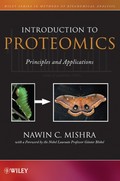Introduction to Proteomics
Principles and Applications
Methods of Biochemical Analysis

1. Edition June 2010
200 Pages, Softcover
Wiley & Sons Ltd
Short Description
Proteomics provides an introductory insight on proteomics, discussing the basic principles of the field, how to apply specific technologies and instrumentation, and example applications in human health and diseases. With helpful study questions, this textbook presents an easy to grasp and solid overview and understanding of the principles, guidelines, and especially the complex instrumentation operations in proteomics for new students and research scientists. Written by a leader in proteomics studies, Proteomics offers an expert perspective on the field and the future of proteomics.
Proteomics provides an introductory insight on proteomics, discussing the basic principles of the field, how to apply specific technologies and instrumentation, and example applications in human health and diseases. With helpful study questions, this textbook presents an easy to grasp and solid overview and understanding of the principles, guidelines, and especially the complex instrumentation operations in proteomics for new students and research scientists. Written by a leader in proteomics studies, Proteomics offers an expert perspective on the field and the future of proteomics.
PREFACE.
ABOUT THE AUTHOR.
CHAPTER 1 HISTORICAL PERSPECTIVES.
1.1. Introduction to Proteomics.
1.2. Proteome and Proteomics.
1.3. Genetics of Proteins.
1.4. Molecular Biology of Genes and Proteins.
1.5. Protein Chemistry Before Proteomics.
References.
Further Reading.
CHAPTER 2 PROTEOMICS--RELATION TO GENOMICS, BIOINFORMATICS.
2.1. Genomics.
2.2. Bioinformatics and Computational Biology.
References.
Further Reading.
CHAPTER 3 METHODOLOGY FOR SEPARATION AND IDENTIFICATION OF PROTEINS AND THEIR INTERACTIONS.
3.1. Separation of Proteins Via a Multidimensional Approach.
3.2. Determination of the Primary Structure of Proteins.
3.3. Determination of the 3D Structure of a Protein.
3.4. Determination of the Amount of Proteins.
3.5. Structural and Functional Proteomics.
References.
Further Reading.
CHAPTER 4 PROTEOMICS OF PROTEIN MODIFICATIONS.
4.1. Phosphorylation and Phosphoproteomics.
4.2. Glycosylation and Glycoproteomics.
4.3. Ubiquitination and Ubiquitinomics.
4.4. Miscellaneous Modifications of Proteins.
References.
Further Reading.
CHAPTER 5 PROTEOMICS OF PROTEIN-PROTEIN INTERACTIONS/INTERACTOMES.
5.1. Protein--Protein Interactions (PPI) in Vivo.
5.2. Analysis of Protein Interactions in Vitro.
5.3. Analysis of Protein Interactions in Silico.
5.4. Synthetic Genetic Methods to Determine Protein Interactions.
5.5. Interactomes.
5.6. Evolution and Conservation of Interactomes.
5.7. Interactomes and the Complexity of Organisms: It is the Number of Interactomes that Matters in Understanding the Complexity of an Organism and not the Number of Genes.
5.8. Interaction of Proteins with Small Molecules.
References.
Further Reading.
CHAPTER 6 APPLICATIONS OF PROTEOMICS I: PROTEOMICS, HUMAN DISEASE, AND MEDICINE.
6.1. Diseasome.
6.2. Medical Proteomics.
6.3. Clinical Proteomics.
6.4. Metaproteomics and Human Health.
6.5. Proteomics in Biotechnology and Industry of Drug Production.
6.6. Metaproteomics of Microbial Fermentation.
6.7. Beef Industry.
6.8. Bioterrorism and Biodefense.
References.
Further Reading.
CHAPTER 7 PROTEOMICS--FUTURE DEVELOPMENTS.
7.1. Technical Scope of Proteomics--Beyond Protein Identification.
7.2. Scientific Scope of Proteomics--Control of Epigenesis.
7.3. Medical Scope of Proteomics.
7.4. Proteomics, Energy Production, and Bioremediation.
7.5. Proteomics and Biodefense.
References.
Further Reading.
INDEX.
This book provides a highly authoritative introduction to the promising and fast-advancing field of proteomics, examining the role proteomics plays in the study of biological systems in general and disease in particular. It helps readers understand the structure, function, and interactions of proteins and how this knowledge is used for identifying diseases and developing new drugs." (Forbes.com, 1 November 2010)
"For undergraduate and graduate biology and non-biology students and new researchers, Mishra (molecular genetics and genomics, U. of South Carolina) introduces the field of proteomics and its role in the study of biological systems and disease." (Book News, September 2010)


